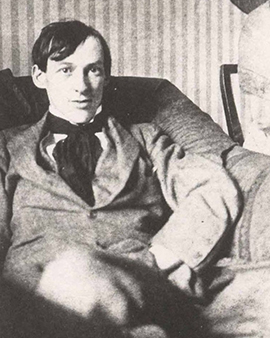For the economic success of British artists in the 19th century it was necessary to be a member of at least one of the well-known artist associations in Great Britain. The more traditional artists, following the cultural and political dictates of the Victorian age, were admitted to the Royal Academy by invitation. Even if the name suggests it, the Royal Academy was only under the patronage of the royal family, financial support did not flow. The second association, the New English Art Club - NEAC for short - was not founded until 1885 in London as an alternative to the Royal Academy. Especially in its early years, the NEAC was a gathering place for the "young wild" artists and art students who showed influences from the continent in their work and left the "English traditions" behind.
One of these "Young Savages" was the artist James Dickson Innes. As a young man, the Welsh man with Scottish-Catalan roots experienced the advances of the late 19th century. James Dickson Innes took his first steps towards becoming a trained painter while still in Wales at the Carmarthen Art School. There he was among the best in his class and was able to transfer to London's Slade School with a small scholarship.
His expression in the picture has raw-looking features. The technique is often simple and strongly reminiscent of the Fauvists or Expressionists of the continent. The works in oil or with watercolours are often similarly structured. Dramatically designed skies lie over wide landscapes. Rivers meander over winding waterfalls away from the viewer or towards the viewer. The brushwork is broad and with the use of large amounts of paint, similar to the late paintings of Henri Matisse. His fine chalk sketches and guachas are quite different. With great attention to detail and subtle use of light and shadow, he opens up rooms or city views to the viewer. In the pictures one often recognizes the mixture of these techniques - unusual for works from this time. People are rarely found in his motifs and if so, they are depicted overlong. Sometimes only at a second glance, they emerge from the background. His study trips led the son of a historian from his beloved Wales first to the European mainland. He travelled to France and Spain. For study purposes he lived in Paris for several years.
From 1911 he decided to settle in the north of Wales together with his friend from Parisian days, Augustus John. There they wanted to live out the romantic idea of an artistic existence: To live a Spartan life, entirely devoted to documenting the beauty of the landscape. Unfortunately, James Dickson Innes did not have a long artistic career. The Welsh painter died at only 27 years of tuberculosis. Most of his paintings are in the collection of the National Museum of Wales.
×





_-_(MeisterDrucke-1466659).jpg)
_-_(MeisterDrucke-1466659).jpg)
.jpg)
.jpg)
.jpg)
.jpg)
.jpg)
.jpg)
_-_(MeisterDrucke-1129726).jpg)
_-_(MeisterDrucke-1129726).jpg)
.jpg)
.jpg)
_-_(MeisterDrucke-1117790).jpg)
_-_(MeisterDrucke-1117790).jpg)
.jpg)
.jpg)
.jpg)
.jpg)
.jpg)
.jpg)
.jpg)
.jpg)
.jpg)
.jpg)
.jpg)
.jpg)
_-_(MeisterDrucke-1484851).jpg)
_-_(MeisterDrucke-1484851).jpg)
_-_(MeisterDrucke-906728).jpg)
_-_(MeisterDrucke-906728).jpg)
.jpg)
.jpg)
.jpg)
.jpg)
_-_(MeisterDrucke-1484630).jpg)
_-_(MeisterDrucke-1484630).jpg)
_-_(MeisterDrucke-906236).jpg)
_-_(MeisterDrucke-906236).jpg)
.jpg)
.jpg)
.jpg)
.jpg)
.jpg)
.jpg)
_-_(MeisterDrucke-1126517).jpg)
_-_(MeisterDrucke-1126517).jpg)
.jpg)
.jpg)
.jpg)
.jpg)
_-_(MeisterDrucke-1644521).jpg)
_-_(MeisterDrucke-1644521).jpg)
.jpg)
.jpg)
_-_(MeisterDrucke-1511326).jpg)
_-_(MeisterDrucke-1511326).jpg)
.jpg)
.jpg)
_-_(MeisterDrucke-901948).jpg)
_-_(MeisterDrucke-901948).jpg)
_-_(MeisterDrucke-1466351).jpg)
_-_(MeisterDrucke-1466351).jpg)
.jpg)
.jpg)
_-_(MeisterDrucke-1133953).jpg)
_-_(MeisterDrucke-1133953).jpg)
.jpg)
.jpg)
.jpg)
.jpg)
.jpg)
.jpg)
_-_(MeisterDrucke-1483538).jpg)
_-_(MeisterDrucke-1483538).jpg)
.jpg)
.jpg)
.jpg)
.jpg)
.jpg)
.jpg)
.jpg)
.jpg)
_-_(MeisterDrucke-1484635).jpg)
_-_(MeisterDrucke-1484635).jpg)
_-_(MeisterDrucke-1483794).jpg)
_-_(MeisterDrucke-1483794).jpg)
.jpg)
.jpg)
 - (MeisterDrucke-649698).jpg)
 - (MeisterDrucke-649698).jpg)
.jpg)
.jpg)
.jpg)
.jpg)
.jpg)
.jpg)
.jpg)
.jpg)
.jpg)
.jpg)
.jpg)
.jpg)




